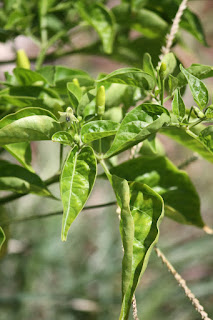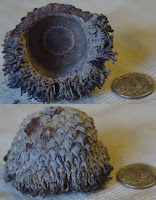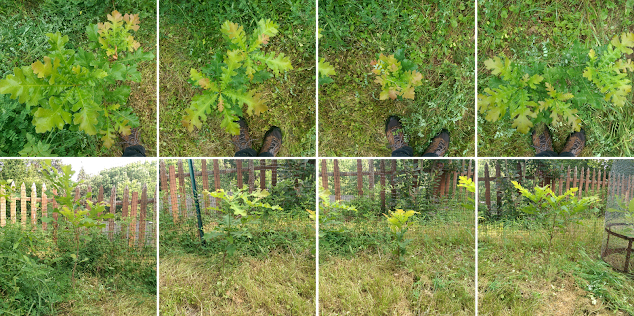Fire is a part of the natural world. Like everything else in the natural world, living systems have evolved to survive, use, or even require fire. We may have a special relationship with fire, but we're not the only ones with an important relationship with fire. When it's in our control, we see it as a constructive force. When it's out of our control, we see it as a destructive force. And rightfully so, because it's both.
 |
| Cropped from image at article. |
The trees didn't notice.
The trees remaining standing among all the destruction led some to believe in conspiracy theories. That the buildings were intentionally burned down. That the horrors and escapes were all fiction. That some hidden government agency murdered all those who died. How could all those buildings have burned and missed burning the trees?
Animals can run or hide. Plants have to deal with what comes there way. So. How did they do it?
The trees that so clearly survived this horrific fire had evolved in an environment that included fire. They have thick fire-resistant bark and they shed their lower branches once they get tall enough. They're adapted to survive the sort of ground fire that destroyed Paradise-CA. (Well, the adults are adapted to survive. Any juvenile trees would have been taken out, but the adults will make more.) The structures we built there were not adapted to survive such a fire. Maybe in the future we'll have building codes appropriate to environments where such fires are possible.
So. The trees are adapted to survive fire. Do any plants -use- fire?
I'd have to travel a bit to see a really good example of this. In Australia there is a type of grass in the genus Triodia that is called Spinifex. (There is a different genus of grass with the name Spinifex, so... I got nothing.) During the dry season the grass become so incredibly flammable that it is almost guaranteed that any large area of the grass will burn every few years. The fires burn hot enough to kill off trees and many other plants. The Spinifex survives and readily regrows from underground stems and seeds resting in the soil. Effectively, the grass uses fire to kill off its competition.
Many other grasses seem to have adapted to use this strategy to greater or lesser degrees, but the evidence isn't always so clear-cut.
Ok. The trees survive fire. The grass uses fire. Do any plants -need- fire?
Another tree, the Jack Pine, often definitely needs fire. Its cones are gummed up with so much hard resin that they can't open to release their seeds until they've been burned by a fast, hot fire. After a fire the seeds are able to rapidly germinate into an environment with much less competition. As well, with the reduced level of fuel, the seedlings will likely be protected from another fire until they're large enough to survive it like the adults do. Without fire, the Jack Pine (and other species with serotinous cones/fruit) cannot reproduce. In the absence of some helpful humans who might crack open the cones with power tools, the trees absolutely need fire.
There are numerous fire-adapted ecosystems around the world, with amazing and diverse species that survive, use, and/or need fire for their continued existence. Though plants can't get out of the way of a fire, they're not the only ones with such intricate relationships with it. Animals and fungi deal with fire too. Those sound like later blog posts. Stay tuned.
References:
- https://en.wikipedia.org/wiki/Camp_Fire_(2018)
- https://www.latimes.com/local/california/la-me-camp-fire-lessons-20181120-story.html
- https://www.agric.wa.gov.au/rangelands/spinifex-rangeland-pastures-and-fire
- https://theconversation.com/spinifex-grass-would-like-us-to-stop-putting-out-bushfires-please-105651
- https://en.wikipedia.org/wiki/Serotiny






















![[no title] At the top are two circles. Yellow at left, with a female symbol beside it; pink at right, with a male & female symbol beside it. Immediately below them, halfway betwen, is another circle representing a hybrid of the above circles. This one is half yellow and half pink, to illustrate the genetic contribution from the parents in the top row. There is only a female symbol beside this circle. There are eleven further circles below. Each is placed horizontally halfway between the previous hybrid and the original pink circle. In each subsequent hybrid circle, the proportion of yellow (as a pie diagram slice) is reduced by half. All the subsequent hybrid circles only have the female symbol beside them. The very bottom circle is filled entirely in pink, representing a male-sterile version of the original [pink] variety.](https://blogger.googleusercontent.com/img/b/R29vZ2xl/AVvXsEhilcbrkIzN3bmY7WmlEm1B-Kzp9sTUPTb2wswruHpykAKWV-F5aPNDGVVVhN7w6bC1Qa7KuAnp6bUHIzvVYlzHf343aeLgz0MUfnVeevaskALZLoFulirF6jdh4JoPCGVz8plJugMir1Wq/s320/male-sterile-strain-construction_2.png)